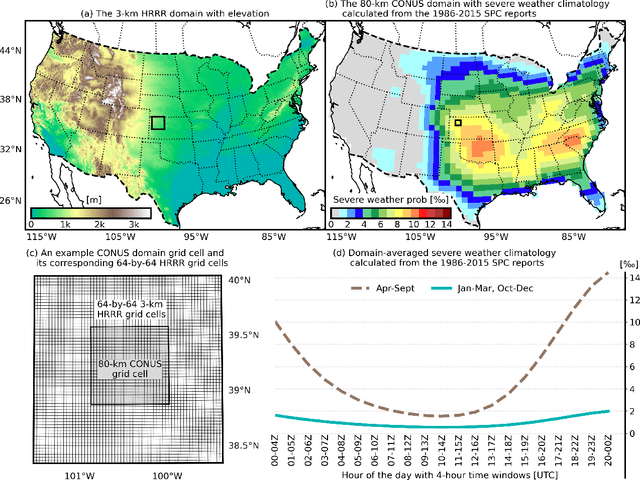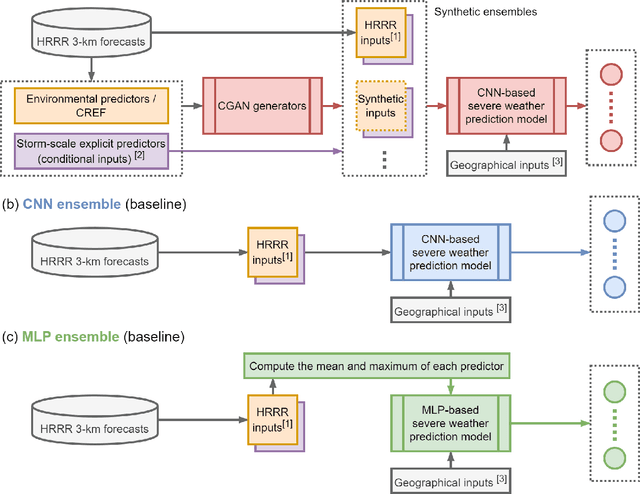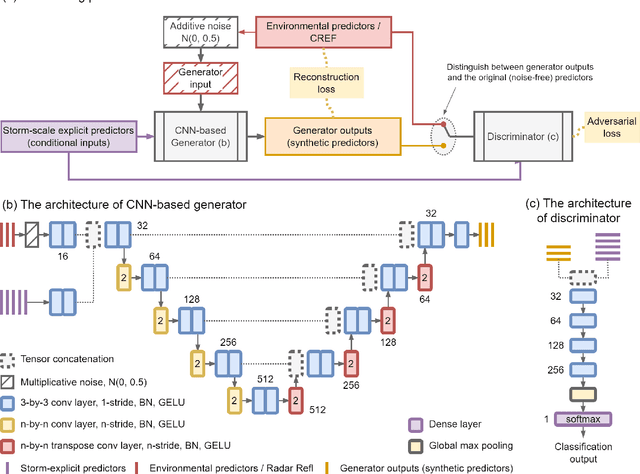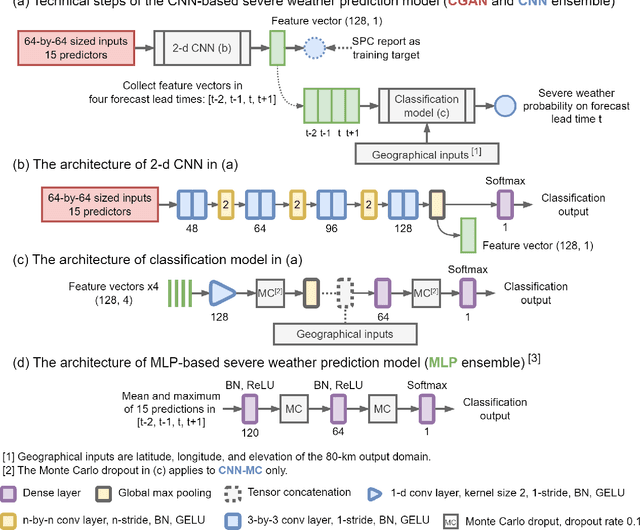Yingkai Sha
Improving Medium Range Severe Weather Prediction through Transformer Post-processing of AI Weather Forecasts
May 16, 2025Abstract:Improving the skill of medium-range (1-8 day) severe weather prediction is crucial for mitigating societal impacts. This study introduces a novel approach leveraging decoder-only transformer networks to post-process AI-based weather forecasts, specifically from the Pangu-Weather model, for improved severe weather guidance. Unlike traditional post-processing methods that use a dense neural network to predict the probability of severe weather using discrete forecast samples, our method treats forecast lead times as sequential ``tokens'', enabling the transformer to learn complex temporal relationships within the evolving atmospheric state. We compare this approach against post-processing of the Global Forecast System (GFS) using both a traditional dense neural network and our transformer, as well as configurations that exclude convective parameters to fairly evaluate the impact of using the Pangu-Weather AI model. Results demonstrate that the transformer-based post-processing significantly enhances forecast skill compared to dense neural networks. Furthermore, AI-driven forecasts, particularly Pangu-Weather initialized from high resolution analysis, exhibit superior performance to GFS in the medium-range, even without explicit convective parameters. Our approach offers improved accuracy, and reliability, which also provides interpretability through feature attribution analysis, advancing medium-range severe weather prediction capabilities.
Community Research Earth Digital Intelligence Twin (CREDIT)
Nov 09, 2024Abstract:Recent advancements in artificial intelligence (AI) for numerical weather prediction (NWP) have significantly transformed atmospheric modeling. AI NWP models outperform traditional physics-based systems, such as the Integrated Forecast System (IFS), across several global metrics while requiring fewer computational resources. However, existing AI NWP models face limitations related to training datasets and timestep choices, often resulting in artifacts that reduce model performance. To address these challenges, we introduce the Community Research Earth Digital Intelligence Twin (CREDIT) framework, developed at NSF NCAR. CREDIT provides a flexible, scalable, and user-friendly platform for training and deploying AI-based atmospheric models on high-performance computing systems. It offers an end-to-end pipeline for data preprocessing, model training, and evaluation, democratizing access to advanced AI NWP capabilities. We demonstrate CREDIT's potential through WXFormer, a novel deterministic vision transformer designed to predict atmospheric states autoregressively, addressing common AI NWP issues like compounding error growth with techniques such as spectral normalization, padding, and multi-step training. Additionally, to illustrate CREDIT's flexibility and state-of-the-art model comparisons, we train the FUXI architecture within this framework. Our findings show that both FUXI and WXFormer, trained on six-hourly ERA5 hybrid sigma-pressure levels, generally outperform IFS HRES in 10-day forecasts, offering potential improvements in efficiency and forecast accuracy. CREDIT's modular design enables researchers to explore various models, datasets, and training configurations, fostering innovation within the scientific community.
Improving ensemble extreme precipitation forecasts using generative artificial intelligence
Jul 05, 2024Abstract:An ensemble post-processing method is developed to improve the probabilistic forecasts of extreme precipitation events across the conterminous United States (CONUS). The method combines a 3-D Vision Transformer (ViT) for bias correction with a Latent Diffusion Model (LDM), a generative Artificial Intelligence (AI) method, to post-process 6-hourly precipitation ensemble forecasts and produce an enlarged generative ensemble that contains spatiotemporally consistent precipitation trajectories. These trajectories are expected to improve the characterization of extreme precipitation events and offer skillful multi-day accumulated and 6-hourly precipitation guidance. The method is tested using the Global Ensemble Forecast System (GEFS) precipitation forecasts out to day 6 and is verified against the Climate-Calibrated Precipitation Analysis (CCPA) data. Verification results indicate that the method generated skillful ensemble members with improved Continuous Ranked Probabilistic Skill Scores (CRPSSs) and Brier Skill Scores (BSSs) over the raw operational GEFS and a multivariate statistical post-processing baseline. It showed skillful and reliable probabilities for events at extreme precipitation thresholds. Explainability studies were further conducted, which revealed the decision-making process of the method and confirmed its effectiveness on ensemble member generation. This work introduces a novel, generative-AI-based approach to address the limitation of small numerical ensembles and the need for larger ensembles to identify extreme precipitation events.
Generative ensemble deep learning severe weather prediction from a deterministic convection-allowing model
Oct 09, 2023



Abstract:An ensemble post-processing method is developed for the probabilistic prediction of severe weather (tornadoes, hail, and wind gusts) over the conterminous United States (CONUS). The method combines conditional generative adversarial networks (CGANs), a type of deep generative model, with a convolutional neural network (CNN) to post-process convection-allowing model (CAM) forecasts. The CGANs are designed to create synthetic ensemble members from deterministic CAM forecasts, and their outputs are processed by the CNN to estimate the probability of severe weather. The method is tested using High-Resolution Rapid Refresh (HRRR) 1--24 hr forecasts as inputs and Storm Prediction Center (SPC) severe weather reports as targets. The method produced skillful predictions with up to 20% Brier Skill Score (BSS) increases compared to other neural-network-based reference methods using a testing dataset of HRRR forecasts in 2021. For the evaluation of uncertainty quantification, the method is overconfident but produces meaningful ensemble spreads that can distinguish good and bad forecasts. The quality of CGAN outputs is also evaluated. Results show that the CGAN outputs behave similarly to a numerical ensemble; they preserved the inter-variable correlations and the contribution of influential predictors as in the original HRRR forecasts. This work provides a novel approach to post-process CAM output using neural networks that can be applied to severe weather prediction.
 Add to Chrome
Add to Chrome Add to Firefox
Add to Firefox Add to Edge
Add to Edge